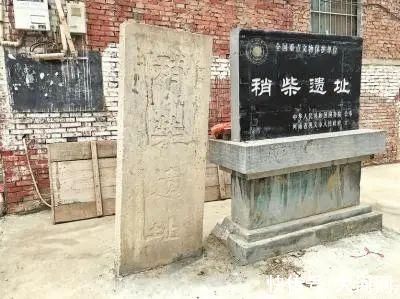城址$双语说河南|在中原 追寻夏的轨迹( 八 )
花地嘴遗址是新砦期遗存的代表性遗址,新砦期遗存是“后羿代夏”时期的文化,有研究者认为,花地嘴遗址可能是“后羿代夏”之后,夏国君太康的五个弟弟困于洛汭作《五子之歌》的地方。
Major discoveries include the remains of four ring trenches, sacrificial pits, southeast gates, a teeth-shaped Zhang (a kind of blade used as ritual implement) made of black jade and two pottery wares painted with cinnabar.
重要遗迹遗物:四条环壕、祭祀坑、东南大门、墨玉牙璋和朱砂绘陶瓮。

文章插图
The Shaochai Site in Gongyi: Uncover Secrets of the Xia Dynasty under the Ordinary Field
巩义稍柴遗址:伊洛河边夏的密码
Many historical documents record that Henan's western part was a main living area for the people of the Xia Dynasty. Since Zhenxun (斟鄩), a capital city of the Xia Dynasty, was located between the Yihe River and the Luohe River, Gongyi therefore became one of the main areas of the people at that time. The Shaochai Site is located in Shaochai village (1.5 kilometers east of Xiaozidian viallge) with the Yiluo River to its north. The Wuluo River flows into the Yiluo River from the southeast of the site. That is to say, the site is located on the tableland where the Wuluo River meets the Yiluo River. Around Shaochai village, there are many places that probably have some relationship with Zhenxun, such as Xunxi (鄩溪), Shangxun (上鄩) and Xiaxun (下鄩). The family name of Xun (寻) also originated from here.
史书中记载夏人在今河南豫西地区活动甚多。夏都斟鄩位于伊洛之间,巩义地区即成为史书记载中夏人的主要活动地域之一。稍柴遗址位于巩义市西南10公里处芝田镇稍柴村及小訾殿村,北面紧临伊洛河,坞罗河从遗址东南向西北流入伊洛河,遗址即在坞罗河与伊洛河交汇的台地上。稍柴村附近和斟鄩有关的地名不少,有鄩溪、有上鄩、下鄩,这里是寻姓的起源地之一。
In 1960 and 1963, the Shaochai Site was excavated twice. Although only 690 square meters was excavated, a large number of relics of the Erlitou Culture (around 1735 BC-1530 BC), the Erligang Culture (around 1600 BC-1400 BC), etc., were discovered. The remains are mainly of the Erlitou Culture (covering three stages), including house foundations, ash pits and tombs. More than 500 pieces of pottery wares, stone tools, bone implements and clam artifacts were unearthed. The discovery of large bones used in sacrificial rituals and proto-porcelains indicates that the settlement at the Shaochai area during the Erlitou Culture and the Erligang Culture not only was of higher rank, but also occupied an important position. Therefore, the site is not only significant for China's Xia-Shang-Zhou Chronology Project and the Project for Tracing Chinese Civilization Origins, but also indispensable for the study of the Xia Dynasty. Currently the focus is to make a thorough investigation of the site. Fortunately, the investigation has made a lot of discoveries, one of which is the finding of a large trench with a length of several hundred meters at the edge of the distribution area of the relics of the Xia and Shang dynasties in the north of the village. Therefore, it is clear that the site was a high-level settlement in the Xia and Shang dynasties.
考古工作者曾对稍柴遗址进行过两次发掘,发现的遗迹数量较多。遗址包含有二里头文化、二里岗文化等时期遗存。以二里头文化遗存为主,核心堆积是二里头文化一期、二期、三期的堆积,已经发现的遗迹类型主要有房基、灰坑和墓葬等,出土陶、石、骨、蚌等各类遗物500余件。尤其是大型卜骨和原始瓷的发现表明,稍柴聚落在伊洛河下游地区二里头文化时期和二里岗文化时期的聚落群中等级较高且占有重要地位,被列为夏商周断代工程与中华文明探源工程的重要研究对象和我国夏文化研究的重点遗址之一。目前正在进行的调查勘探中,在夏商遗存分布区的边缘发现了长达数百米的大型围沟,足以证明这里是夏商时期一处等级较高的聚落。
- 小说$6本男主假高冷小说,强推《镇河》好好笑,作者脑洞未免也太大了
- 王之心&四本开局就惊艳读者的小说,一看书名就想入坑,书荒的你值得拥有
- 船夫&新科状元乘船回家,船夫随口说出一上联,状元却至死都没对出来
- 热血小说$15年老书虫推荐3本百看不厌的热血小说,值得你通宵达旦看完啊!
- 梁炎东!3部强逻辑悬疑小说,人间修罗案神乎其神,谁能戳破鬼怪谣言?
- |茅奖小说《暗算》出版20年,精装版归来继续密码和人心全解密
- 逍遥小书生!五本不输《赘婿》的架空历史小说,评分高达9.5!全部都是精品
- 方腊#鲁智深生擒方腊后说了2句话,共6个好汉听懂了,离开宋江得善终
- 进化&碾压《诡秘之主》,反超《牧神记》,辰东这本小说爆红逆袭登顶
- 帕子@《我的前夫是宦官》当我的丈夫是个宦官,我和他不得不说的故事!
